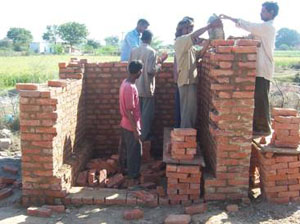|
Improved Pottery Kiln : A
Bundelkhand Initiative Satish Pawar satishm_2002@yahoo.co.in & Rajesh Bakpai energy_raj@yahoo.com A mong the ten major artisan groups in India, potters comprise the fourth largest and second poorest group, with an estimated ten lakhs people
directly or indirectly involved in this vocation. Despite the existence
of a stable and consistent demand for a narrow range of pottery ware,
these traditional potters are in a deep crisis due to the severe
competition from industrial products like plastics and aluminium goods. poorest group, with an estimated ten lakhs people
directly or indirectly involved in this vocation. Despite the existence
of a stable and consistent demand for a narrow range of pottery ware,
these traditional potters are in a deep crisis due to the severe
competition from industrial products like plastics and aluminium goods.
They are unable to meet this challenge since there has been a drastic depletion of raw materials as suitable clay becomes more and more scarce, while there is no innovation or upgradation of their skills and technologies. The shrinking market for traditional wares threatened the livelihoods of the artisans whose skills were very limited. Bundelkhand (14 districts, 1200 villages) and Datia (Badoni village) are the two regions adopted for the pottery kiln technology dissemination. Presently, all the villagers use the conventional firing method for firing their pots. The fuel they are using is mainly dung cakes and small branches of dried wood. Pipra and Datia have relatively large kilns, with a typical pottery kiln being a pit,6-7 feet deep and about 25 feet in diameter. In the Niwari cluster, the kilns are very shallow and the wares are in small lots. Wares are even fired in a 5-6 feet patch in front of the potter’s house. In traditional firing, the consumption of fuel is very high. In traditional kilns, the fuel and the green wares are stacked in layers and then ignited. The fuel used for firing the wares is cow dung cake, paddy straw and small twigs. In deeper kilns in Datia sector, firing takes about one to two days and in the Niwari cluster, where the number of wares fired in a batch is small, firing takes a single day. Each firing in the large kiln requires 5000 dung cakes and two bags of paddy straw (100 dung cakes cost Rs.50 and paddy straw costs Rs.30).
Pottery kilns would have a universal appeal, as firing of pots is not confined to any specific season or cluster. It is
important to understand the traditional method of firing of wares,
because the use of an improved kiln would require that the potter
deviates significantly from this conventional practice. Improved pottery
kilns offer
Improved pottery kilns installed in the Karnataka have shown a 30% reduction in fuel consumption over the traditional kiln, but this percentage may differ in the Bundelkhand region. Improved kiln would also reduce the firing time from the current days having a positive impact on the productivity of the operation. The atmosphere in the vicinity of the kiln is much cleaner due to its environment friendly system of operation. The improved kiln designs are currently available in two sizes, which are - 80 cubic feet and 180 cubic feet.
The kiln consists of two chambers separated by a brick vault construction with gaps to withstand high temperature and to bear the load of the wares. Fuel is burnt in the lower chamber and the wares are stacked in the upper chamber.
The volumetric ratio between the lower combustion chamber, and the upper chamber where wares are loaded, is 1:1.3 to maximize the capacity of the kiln and also facilitate a good draft. Metal clamps are fitted to the external wall of the kiln to enable it to withstand the thermal expansion. q
|
|||||||||||||||||||||||||||||||||||||||||||||||||||||||||||||||||||||||||||
 The kilns
to fire pottery wares were one of the challenging products we adopted
under the SHELL Project. Potters use these kilns to bake pots of
different size and shape. Improved pottery kilns were taken up for
dissemination under the project. For several reasons, the new kiln would
offer considerable advantages over the conventional kiln. An Improved
kiln would add to the profits of the artisans by saving in terms of the
fuel cost and reduction in the percentage of breakages. It is less
accident-prone, because of the closed firing method and it uses less
manpower while in operation.
The kilns
to fire pottery wares were one of the challenging products we adopted
under the SHELL Project. Potters use these kilns to bake pots of
different size and shape. Improved pottery kilns were taken up for
dissemination under the project. For several reasons, the new kiln would
offer considerable advantages over the conventional kiln. An Improved
kiln would add to the profits of the artisans by saving in terms of the
fuel cost and reduction in the percentage of breakages. It is less
accident-prone, because of the closed firing method and it uses less
manpower while in operation.  reduction in the cost of fuel as well as a considerable
reduction in the percentage of breakages , which results in an improved
profitability in the pottery firing operation.
reduction in the cost of fuel as well as a considerable
reduction in the percentage of breakages , which results in an improved
profitability in the pottery firing operation.  earth
have a strong potential to meet the need of the growing
populations across the world. Particularly in the case of water
stressed areas, water veins hold the key to revival of life and
livelihood. According to an unpublished document by DWL, ‘Serving
people with water: A short introduction’, "…talking about a system
of underground water veins that always are under a certain
pressure and deliver all year long the same quantity of water
means leaving today’s scientific order. But finally we have to
consider the results! How is it otherwise possible that on a tiny
Philippine island (300 x 400 m) at a depth of app. 60 m a source
with a constant flow of 500 l/min. was opened up? How is it
possible that the water on hilltops is closest to the surface? The
whole system can’t be explained in a few sentences and we must
concentrate on the results and with such a high success rate we
are out of coincidence."
earth
have a strong potential to meet the need of the growing
populations across the world. Particularly in the case of water
stressed areas, water veins hold the key to revival of life and
livelihood. According to an unpublished document by DWL, ‘Serving
people with water: A short introduction’, "…talking about a system
of underground water veins that always are under a certain
pressure and deliver all year long the same quantity of water
means leaving today’s scientific order. But finally we have to
consider the results! How is it otherwise possible that on a tiny
Philippine island (300 x 400 m) at a depth of app. 60 m a source
with a constant flow of 500 l/min. was opened up? How is it
possible that the water on hilltops is closest to the surface? The
whole system can’t be explained in a few sentences and we must
concentrate on the results and with such a high success rate we
are out of coincidence."